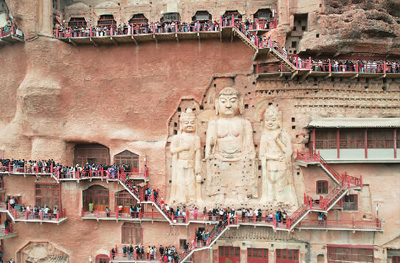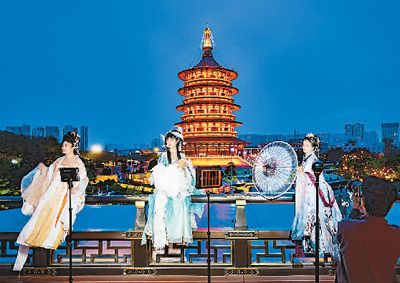




- BRNN
- BRI News
- BRNN News
- Database
Official Documents Polices and Regulations
Inter-government Documents International Cooperation BRI Countries
Business Guide Economic Data BRI Data
Trade
Investment Projects Latest projects
Cases - Content Pool
Since the beginning of this year, tourism markets in multiple regions across China have been thriving. In addition to traditional well-known tourist destinations, small cities like Tianshui and Quanzhou have been attracting throngs of tourists with their local characteristics.
The rapid tourism growth in small cities has become a new highlight for domestic travel.

Aerial photo shows tourists crowding around at the Maijishan Grottoes in Tianshui, northwest China's Gansu Province. (Xinhua/Zhang Zhimin)
Records from the Ministry of Culture and Tourism show that during the three-day Qingming Festival holiday that ended on April 6, the number of tourists received by Tai'an, Zibo, Tianshui, Kaifeng, and Jingdezhen all increased by more than 50 percent.
Compared to previously popular destinations that were mostly well-known tourist cities or big metropolises, some distinctive small cities have been attracting greater attention.
The choices of destinations by tourists have become more diverse as they have sought unique and differentiated experiences. Against such a background, a local delicacy, an event, or a scenario in small cities may draw massive crowds of tourists.
Following last year's popularity of Zibo's barbecue and Liuzhou's luosifen, or river snail rice noodles, Tianshui malatang, an iconic dish of hot pot, has spiced up tourism in the previously little-known northwestern city this year.
Data from online travel service provider Qunar shows that the search volume for Tianshui on the platform since Feb. 26 had skyrocketed 2,000 percent year on year. During the Qingming Festival holiday, hotel bookings in the city had increased 12 times.

Visitors pose for photos in the National Archaeological Site Park of Sui-Tang Luoyang City in Luoyang, central China's Henan Province. (Photo/Li Weichao)
Data from Tujia, an online platform for booking B&B hotels, shows that as of April 6, the booking volume for B&B hotels in Tianshui, Datong, and Zibo had increased 18.8 times, 18.5 times, and 14.5 times year on year, respectively. Cities like Jinzhou, Hanzhong, Xuzhou, Xuancheng, Jingdezhen, Dandong, and Yanbian also had experienced a significant growth in B&B bookings.
Embarking on a unique journey in small cities has become an increasingly popular choice among tourists. During the Qingming Festival holiday, flight bookings to destinations like Zhanjiang, Mangshi, Zhoushan, Yanji, Nyingchi, Yiwu, Shangrao, Enshi, Jingdezhen, and Nanyang had more than tripled from the same period last year, data from Qunar shows.
Many small Chinese cities that experience a tourism boom boast a unique cultural charm.
In Luoyang city, Hanfu, a type of traditional Chinese garment, has been attracting flocks of visitors. Records from e-commerce service platforms Meituan and Dazhong Dianping show that since April, the volume of tourism consumption orders in Luoyang saw a month-on-month increase of 130 percent, making it among the top 10 tourism destinations nationwide. The search volume for "Hanfu" in Luoyang ranked second in the country, with searches for "men's Hanfu" surged by 550 percent year on year.
In Quanzhou, donning Xunpu flowery headwear, a signature of "Xunpu Women Customs" that was listed as a national intangible heritage, while visiting the city has become the most popular tourism experience for tourists from across the country.

Tourists watch a local marionette show in Quanzhou city, southeast China's Fujian Province. (Xinhua/Zhou Yi)
An increasing number of small cities have unleashed new dynamism for cultural and tourism consumption, showcasing new development trends in the cultural and tourism industry.
These cities boast time-honored cultural and tourism resources, as well as unique and charming cultural and tourism products, explained Feng Ling, a professor from the School of Tourism Sciences at Beijing International Studies University.
In recent years, many cities have rolled out quality cultural and tourism products that have become more popular. The rise of Hanfu fever and a museum craze has also demonstrated the appeal of outstanding traditional culture, as tourists have been willing to pay for related cultural and tourism products. An important factor for the booming tourism in these cities has been a sound cycle between supply and demand in the sector.
Feng believes that more small cities rich in cultural resources will become popular tourist destinations.

Tel:86-10-65368972, 86-10-65369967